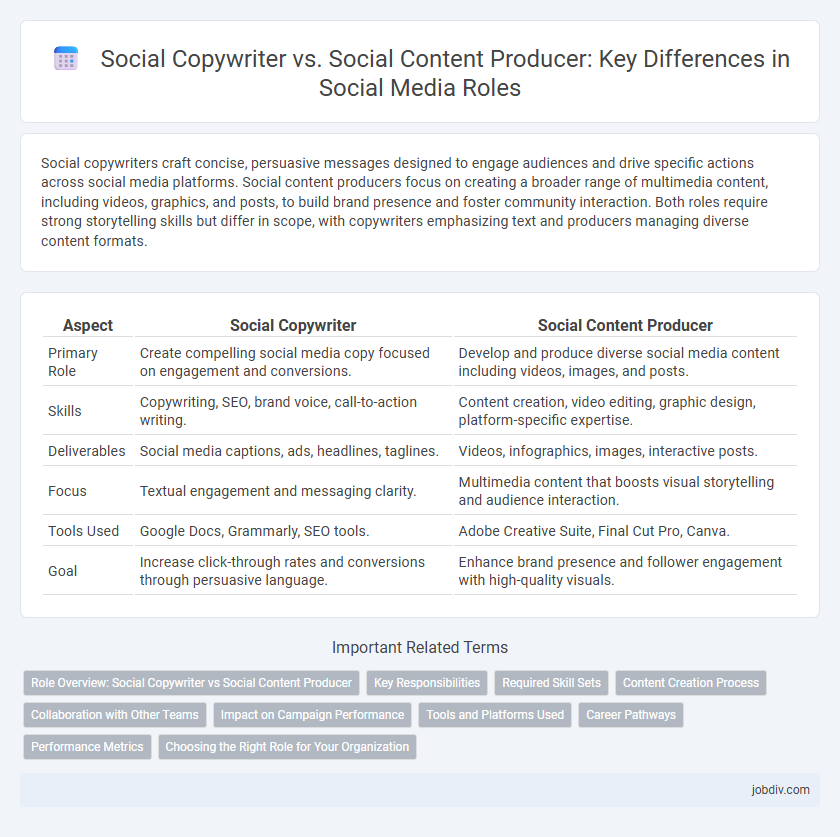Social copywriters craft concise, persuasive messages designed to engage audiences and drive specific actions across social media platforms. Social content producers focus on creating a broader range of multimedia content, including videos, graphics, and posts, to build brand presence and foster community interaction. Both roles require strong storytelling skills but differ in scope, with copywriters emphasizing text and producers managing diverse content formats.
Table of Comparison
| Aspect | Social Copywriter | Social Content Producer |
|---|---|---|
| Primary Role | Create compelling social media copy focused on engagement and conversions. | Develop and produce diverse social media content including videos, images, and posts. |
| Skills | Copywriting, SEO, brand voice, call-to-action writing. | Content creation, video editing, graphic design, platform-specific expertise. |
| Deliverables | Social media captions, ads, headlines, taglines. | Videos, infographics, images, interactive posts. |
| Focus | Textual engagement and messaging clarity. | Multimedia content that boosts visual storytelling and audience interaction. |
| Tools Used | Google Docs, Grammarly, SEO tools. | Adobe Creative Suite, Final Cut Pro, Canva. |
| Goal | Increase click-through rates and conversions through persuasive language. | Enhance brand presence and follower engagement with high-quality visuals. |
Role Overview: Social Copywriter vs Social Content Producer
A Social Copywriter specializes in crafting engaging, persuasive text tailored for specific platforms to drive user action and brand messaging. In contrast, a Social Content Producer oversees the creation, coordination, and publication of diverse multimedia content, ensuring consistency across social channels. Both roles demand strong storytelling skills, but the Copywriter focuses primarily on written communication, while the Producer manages the broader content strategy and execution.
Key Responsibilities
Social Copywriters specialize in crafting persuasive, concise text tailored for social media ads, captions, and promotional content, ensuring high engagement and brand voice consistency. Social Content Producers manage multimedia content creation, including videos, graphics, and interactive elements, coordinating production schedules and platform-specific adaptations. Together, these roles enhance a brand's social presence by combining targeted messaging with dynamic visual storytelling.
Required Skill Sets
Social copywriters excel in crafting compelling, concise messages tailored for specific target audiences, emphasizing persuasive language and brand voice consistency. Social content producers require a broader skill set, including video editing, graphic design, content strategy, and platform-specific optimization to create engaging multimedia content. Both roles demand strong storytelling abilities, social media analytics knowledge, and adaptability to evolving digital trends.
Content Creation Process
A Social Copywriter specializes in crafting persuasive, concise messages tailored to engage target audiences and drive specific actions on social platforms. In contrast, a Social Content Producer manages the end-to-end content creation process, including ideation, scripting, visual coordination, and publishing across multiple channels. Both roles demand collaboration with design, marketing, and analytics teams to optimize content performance and audience engagement.
Collaboration with Other Teams
Social Copywriters excel at crafting compelling, audience-specific messages that align with brand voice and marketing goals, facilitating seamless collaboration with design and marketing teams to ensure cohesive campaigns. Social Content Producers coordinate the creation, scheduling, and distribution of multimedia content, working closely with social media managers, video editors, and analytics teams to optimize reach and engagement. Both roles enhance cross-functional teamwork by integrating creative insights with strategic execution to drive effective social media presence.
Impact on Campaign Performance
Social copywriters craft concise, persuasive messaging that directly influences audience engagement and click-through rates, driving immediate campaign results. Social content producers develop diverse multimedia assets that build brand awareness and sustain audience interest over time, enhancing long-term campaign effectiveness. Combining the strengths of copywriting and content production maximizes overall campaign performance by balancing quick impact with sustained user interaction.
Tools and Platforms Used
Social Copywriters primarily use tools like Grammarly and Hemingway for crafting compelling, error-free text, alongside social media platforms such as Facebook, Instagram, and Twitter to tailor messages for target audiences. Social Content Producers employ a broader range of tools including Adobe Creative Suite and Canva for visual content creation, along with video editing software like Final Cut Pro or Adobe Premiere, leveraging platforms like YouTube, TikTok, and LinkedIn for diverse multimedia distribution. Both roles rely on analytics tools like Google Analytics and Hootsuite to measure engagement and optimize content strategy.
Career Pathways
Social Copywriters specialize in crafting persuasive and engaging text tailored for specific audiences, emphasizing brand voice and marketing objectives. Social Content Producers manage the creation, coordination, and publication of diverse multimedia content, integrating strategy with platform-specific requirements. Career pathways for Social Copywriters often lead to senior creative roles or brand strategy positions, while Social Content Producers typically advance into content management or digital marketing leadership roles.
Performance Metrics
Social Copywriters focus on crafting persuasive messaging aimed at boosting engagement rates, click-throughs, and conversions by optimizing call-to-actions and brand voice consistency. Social Content Producers prioritize creating and scheduling multimedia content designed to maximize reach, impressions, and shareability across platforms, driving overall audience growth. Performance metrics for copywriters often emphasize conversion rates and CTR, while content producers track content performance through reach, impressions, and audience retention statistics.
Choosing the Right Role for Your Organization
Social copywriters excel in crafting persuasive, concise messages tailored for specific campaigns, effectively driving engagement and conversions through targeted social media ads and posts. Social content producers specialize in developing diverse digital assets, including videos, graphics, and interactive content, to build a cohesive brand presence across multiple platforms. Choosing the right role depends on your organization's primary needs: prioritize social copywriters for focused campaign messaging and conversions, or social content producers for comprehensive content strategy and audience engagement.
Social Copywriter vs Social Content Producer Infographic

 jobdiv.com
jobdiv.com